
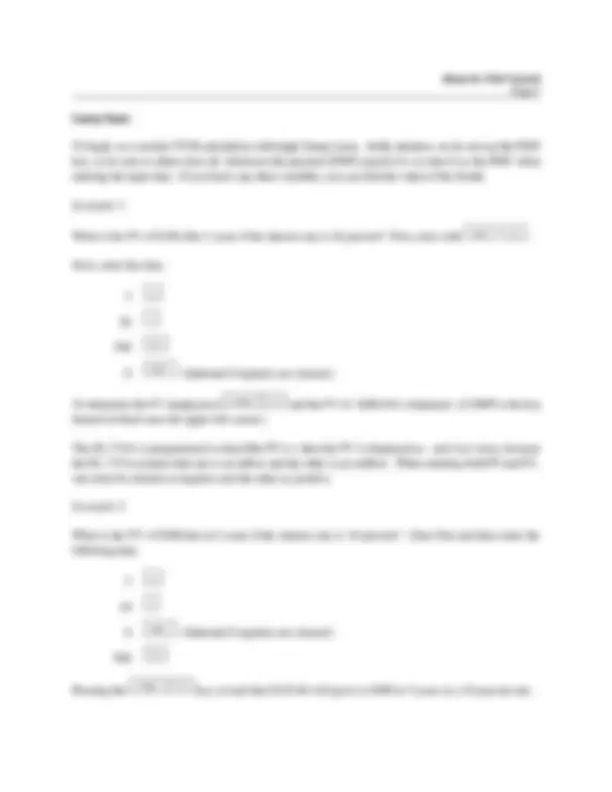
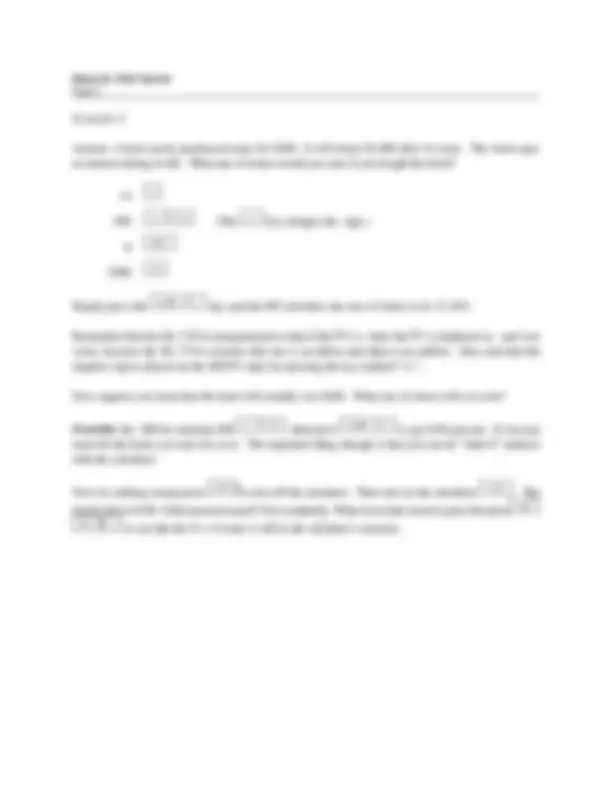
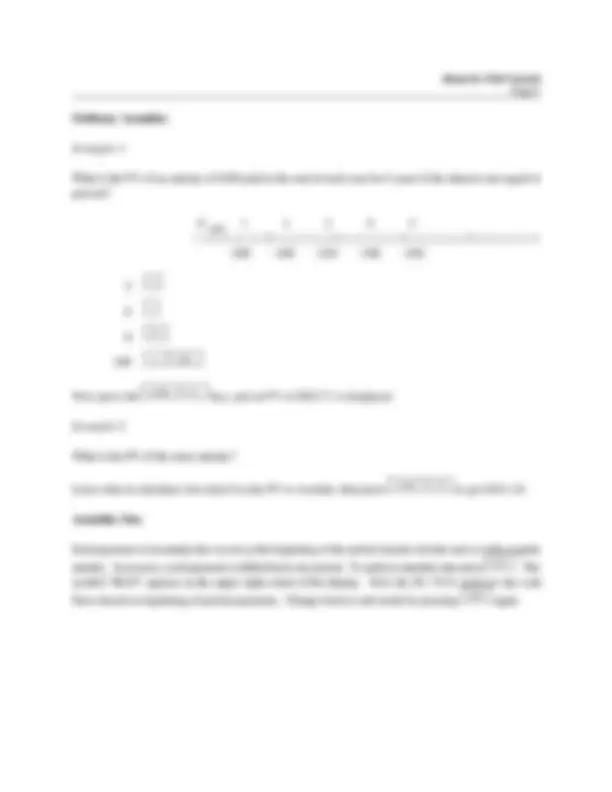
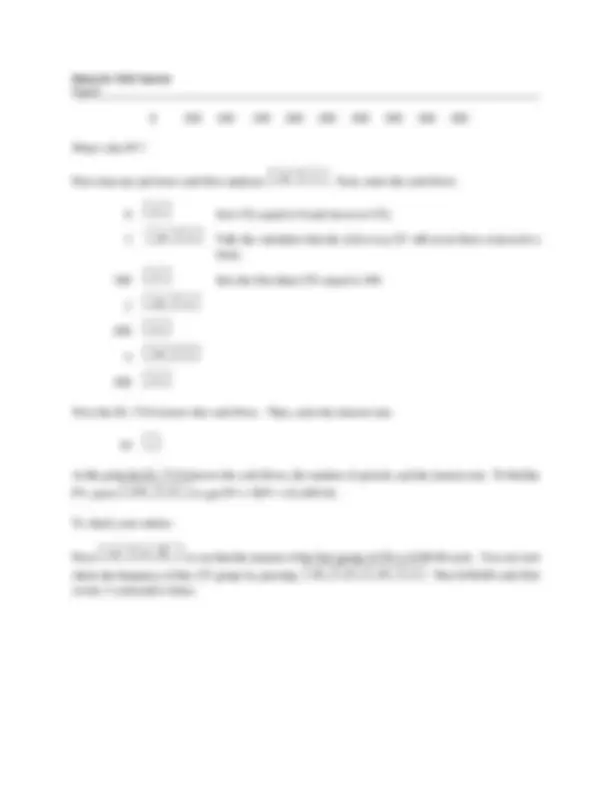
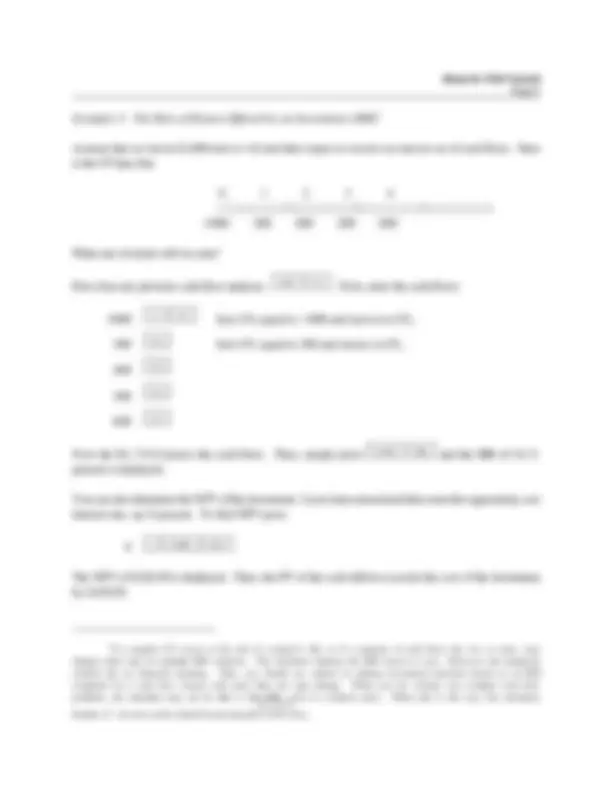
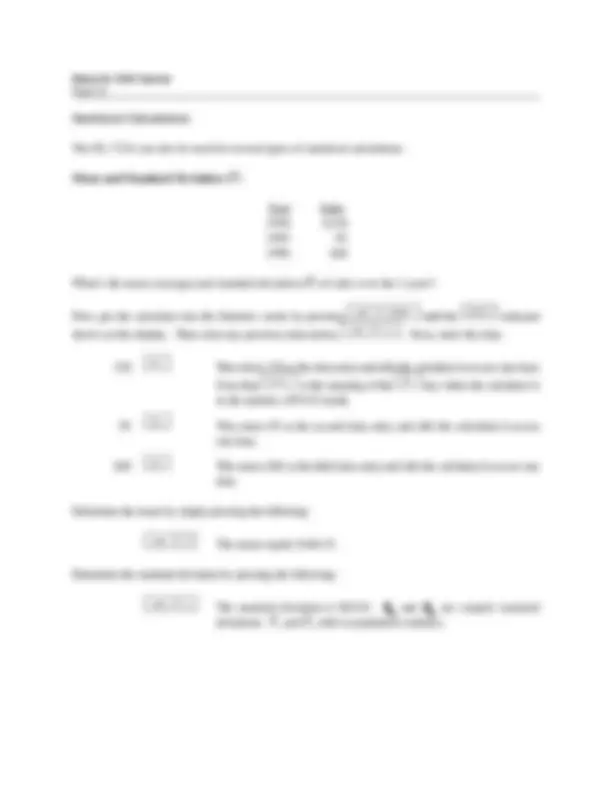
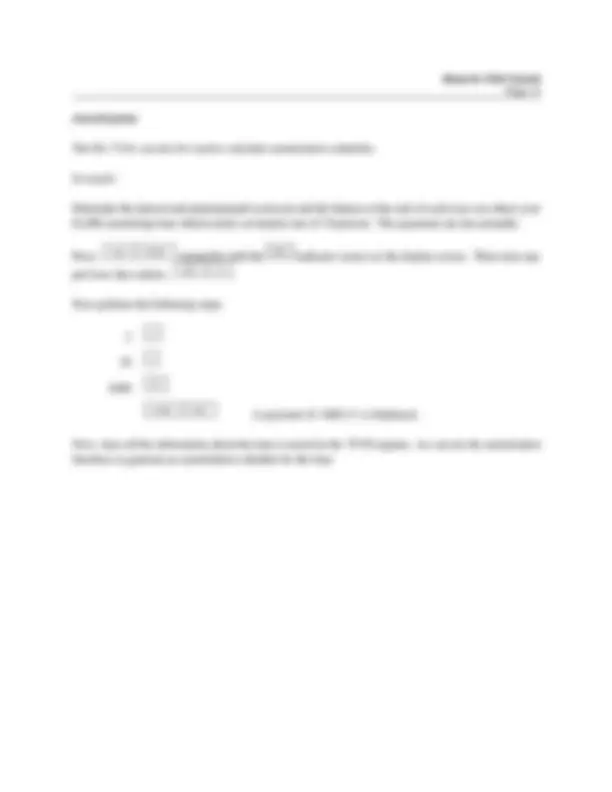
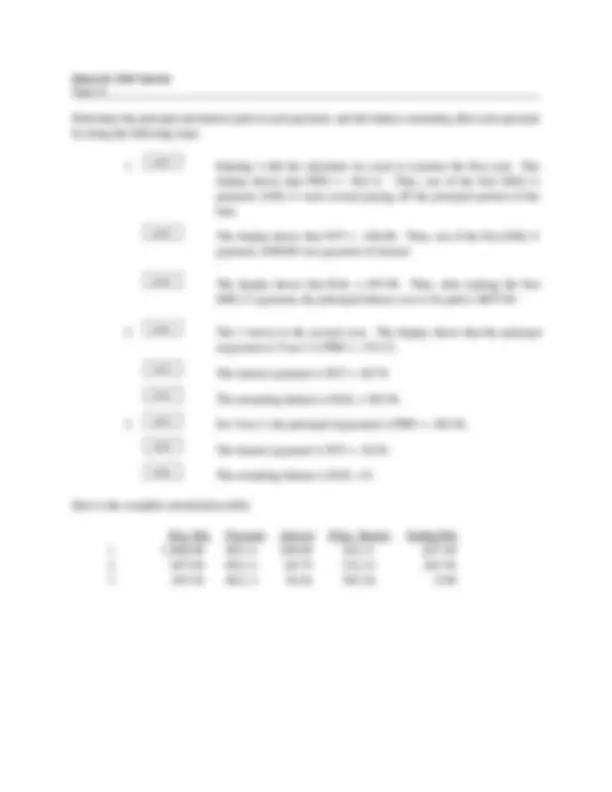


Study with the several resources on Docsity

Earn points by helping other students or get them with a premium plan


Prepare for your exams
Study with the several resources on Docsity

Earn points to download
Earn points by helping other students or get them with a premium plan
Community
Ask the community for help and clear up your study doubts
Discover the best universities in your country according to Docsity users
Free resources
Download our free guides on studying techniques, anxiety management strategies, and thesis advice from Docsity tutors
A tutorial on using the sharp el-733a calculator for financial calculations, including clearing the calculator, changing modes, and performing time value of money (tvm) calculations such as finding the present value (pv), future value (fv), and internal rate of return (irr) of an investment. The tutorial includes examples and explanations of the calculator's functions.
Typology: Study notes
1 / 14

This page cannot be seen from the preview
Don't miss anything!









To begin, look at the face of the calculator. Almost every key on the EL-733A has two functions: each key's primary function is noted on the key itself, while each key's secondary function is noted in reddish- brown above the key. To use the function on the key, simply press the key. To access the function above each key, first press the yellow key with “2ndF” printed on it, which we will call the "2nd function" key, and then press the desired function key. (Note that the 2nd function key is located at the upper left corner of the calculator keyboard.)
Turning the Calculator On and Off
To turn on the calculator, press C-CE^. To turn off the calculator, press OFF.
Note that the ON and OFF keys are in the upper right corner of the keyboard. Also, we will designate keys throughout this tutorial by the use of small boxes, as above. To conserve the battery, the calculator turns itself off about 10 minutes after your last keystroke.
Also, note that pressing the 2nd function key places a little “2ndF” symbol in the upper left corner of the
display. Press the 2nd function key again and the symbol goes away. The 2ndF key is a toggle key that
switches back and forth between the “regular” and the “2nd” functions. 2ndF is like the typewriter shift
key. After you press 2ndF , look only at the reddish-brown writing above the keys.
Note that the calculator has a continuous memory, so turning it off does not affect any data stored in the calculator, but will erase any number showing on the screen.
Clearing the Calculator
Three of the most commonly used methods of clearing data are presented below:
2ndF CA Clears all the memory registers associated with a particular mode (normal, FIN, or STAT). C-CE Clears the entire display, but not the memory.
≡ Clears numbers on the display one at a time if you made a mistake entering data.
Review your owner’s manual for other methods of clearing information.
Page 2
Clearing the calculator is very important, since unwanted data in memory can result in improper calculations, and hence wrong answers. It is best to get into the habit of automatically clearing memory before starting a calculation. Occasionally, you may purposely want to save data, but, in general, you will be entering all new data, so starting with a clear memory is the safest approach.
Changing the Display
To change decimals from 2 to 4, press 2ndF^ TAB^4. 0.0000 is displayed.
To change from 4 places to 2, press 2ndF^ TAB^2. 0.00 is displayed.
We usually set the display to 2 places, which is especially convenient when working with dollars and percentages. However, we often use 4 places when dealing with interest rates and rates of return that are entered as decimals.
Changing the Mode
The calculator has three calculation modes: NORMAL, FIN (financial), and STAT (statistics). The mode of the calculator dictates the type of calculations that can be performed. When working financial problems, you will typically use the FIN mode, while statistical problems normally will be handled in STAT mode. Modes are indicated in the display as follows: a box showing “FIN” indicates finance mode, a box showing “STAT” indicates statistics mode, and no box appears when in the normal mode. To change modes, simply
press, 2ndF^ MODE. The calculator rotates through the modes from normal to finance to statistics to normal.
Time Value of Money (TVM)
The TVM keys are located on the third row from the top of the keyboard.
n i PV FV PMT
To enter the time value of money mode do the following:
Press 2ndF^ MODE^ repeatedly until the FIN indicator appears in the display.
In general, TVM problems involve four variables—three are known and the fourth is unknown.
Page 4
Example 3:
Assume a bond can be purchased today for $200. It will return $1,000 after 14 years. The bond pays no interest during its life. What rate of return would you earn if you bought the bond?
14 n
200 +/-^ PV^ (The +/- key changes the sign.)
0 PMT
1000 FV
Simply press the COMP^ i key and the HP calculates the rate of return to be 12.18%.
Remember that the EL-733A is programmed so that if the PV is + then the FV is displayed as - and vice versa, because the EL-733A assumes that one is an inflow and other is an outflow. Also, note that the negative sign is placed on the 200 PV entry by pressing the key marked “+/-”.
Now suppose you learn that the bond will actually cost $300. What rate of return will you earn?
Override the -200 by entering 300 +/-^ PV^ , then press COMP^ i to get 8.98 percent. If you pay more for the bond, you earn less on it. The important thing, though, is that you can do “what if” analyses with the calculator.
Now do nothing except press OFF^ to turn off the calculator. Then turn on the calculator C-CE. The
display shows 0.00. Is the memory erased? Not completely. What was on the screen is gone, but press 2ndF RCL n to see that the N = 14 entry is still in the calculator’s memory.
Page 5
Ordinary Annuities
Example 1:
What is the FV of an annuity of $100 paid at the end of each year for 5 years if the interest rate equals 6 percent?
(^0) 6% 1 2 3 4 5 /))))))))3))))))))3))))))))3))))))))3)))))))) -100 -100 -100 -100 -
5 n
6 i
0 PV
100 +/-^ PMT
Now press the COMP^ FV key, and an FV of $563.71 is displayed.
Example 2:
What is the PV of the same annuity?
Leave data in calculator, but enter 0 as the FV to override, then press COMP^ PV to get $421.24.
Annuities Due
Each payment of an annuity due occurs at the beginning of the period instead of at the end as with a regular
annuity. In essence, each payment is shifted back one period. To analyze annuities due press BGN. The symbol “BGN” appears in the upper right corner of the display. Now the EL-733A analyzes the cash
flows based on beginning of period payments. Change back to end mode by pressing BGN again.
Page 7
Cash Flow Operations
We can also find the PV, FV, and IRR (internal rate of return) of a series of unequal cash flows.
Example 1: Uneven Cash Flows
Assume the following cash flows:
(^0) 10% 1 2 3 4 /))))))))3))))))))3))))))))3)))))))) 0 50 100 150 200
What is the PV of these CFs?
First clear any previous cash flow or TVM analyses by pressing 2ndF^ CA. Next, enter the cash flows:
0 CF i Sets CF 0 equal to 0 and moves to CF 1.
50 CF i Sets CF 1 equal to 50 and so on.
100 CF i
150 CF i
200 CF i
The CFs from the time line are entered. Now enter the interest rate.
10 i
At this point the EL-733A knows the cash flows, the number of periods, and the interest rate. To find the
PV, press COMP^ NPV to get PV = NPV = $377.40.
Example 2: Embedded Annuities
We have these cash flows, which contain embedded annuities:
(^0) 10% 1 2 3 4 5 6 7 8 9
/)))))))3))))))3))))))3))))))3))))))3))))))3))))))3))))))3)))) ))
Page 8
0 100 100 100 200 200 300 300 300 300
What’s the PV?
First clear any previous cash flow analyses, 2ndF^ CA. Next, enter the cash flows:
0 CF i Sets CF 0 equal to 0 and moves to CF 1.
3 2ndF^ N i Tells the calculator that the following CF will occur three consecutive times.
100 CF i Sets the first three CFs equal to 100.
2 2ndF^ N i
200 CF i
4 2ndF^ N i
300 CF i
Now the EL-733A knows the cash flows. Thus, enter the interest rate:
10 i
At this point the EL-733A knows the cash flows, the number of periods, and the interest rate. To find the
PV, press COMP^ NPV to get PV = NPV = $1,099.94.
To check your entries:
Press 2ndF^ RCL^1 to see that the amount of the first group of CFs is $100.00 each. You can now
check the frequency of this CF group by pressing 2ndF^ RCL^ 2ndF^ N i. This $100.00 cash flow occurs 3 consecutive times.
Page 10
Statistical Calculations
The EL-733A can also be used for several types of statistical calculations.
Year Sales 1994 $ 1995 95 1996 260
First, put the calculator into the Statistics mode by pressing 2ndF^ MODE^ until the STAT indicator
shows on the display. Then clear any previous data entries, 2ndF^ CA. Next, enter the data:
150 M+ This enters 150 as the data entry and tells the calculator it occurs one time. Note that DATA^ is the meaning of the M+ key when the calculator is in the statistics (STAT) mode.
95 M+ This enters 95 as the second data entry and tells the calculator it occurs one time.
260 M+ This enters 260 as the third data entry and tells the calculator it occurs one time.
Determine the mean by simply pressing the following:
_ 2ndF X The mean equals $168.33.
Determine the standard deviation by pressing the following:
2ndF Sx The standard deviation is $84.01. and are sample standard
Page 11
Linear Regression
Beta coefficients can be calculated by using the EL-733A’s linear regression capabilities. The X (independent variable) and Y (dependent variable) values must be entered in the proper sequence, where the X data is on the horizontal axis ( market ) and Y data is on the vertical axis ( stock ).
____Year __________Market (km )^ ________Stock (kj) 1 23.8% 38.6% 2 -7.2 -24. 3 6.6 12. 4 20.5 8. 5 30.6 40.
First, put the calculator into the Statistics mode by pressing 2ndF^ MODE^ until the STAT indicator
shows on the display. The clear any previous data entries, 2ndF^ CA. Next, enter the data as follows:
23.8 RM^ This enters 23.8 as the first X variable. (The RM key in the STAT mode is the (x, y) key.)
38.6 M+ This enters 38.6 as the first Y variable.
7.2 +/-^ RM This enters -7.2 as the second X variable.
24.7 +/-^ M+ This enters -24.7 as the second Y variable.
6.6 RM This enters 6.6 as the third X variable.
12.3 M+ This enters 12.3 as the third Y variable.
20.5 RM This enters 20.5 as the fourth X variable.
8.2 M+ This enters 8.2 as the fourth Y variable.
30.6 RM This enters 30.6 as the fifth X variable.
40.1 M+ This enters 4.1 as the fifth Y variable.
Determine the intercept by pressing 2ndF^ a. The display shows that “a,” which is the vertical axis
intercept , is equal to -8.92. To find the slope simply press 2ndF^ b. The display shows that “b” is equal to 1.60, which is the slope coefficient and the beta coefficient.
Page 13
Amortization
The EL-733A can also be used to calculate amortization schedules.
Example:
Determine the interest and principal paid each year and the balance at the end of each year on a three-year $1,000 amortizing loan which carries an interest rate of 10 percent. The payments are due annually.
Press 2ndF^ MODE^ repeatedly until the FIN indicator comes on the display screen. Then clear any
previous data entries, 2ndF^ CA.
Now perform the following steps:
3 n
10 i
1000 PV COMP PMT A payment of -$402.11 is displayed.
Now, since all the information about the loan is stored in the TVM register, we can use the amortization functions to generate an amortization schedule for the loan.
Page 14
Determine the principal and interest paid in each payment, and the balance remaining after each payment by doing the following steps:
1 AMRT Entering 1 tells the calculator we want to examine the first year. The display shows that PRN = -302.11. Thus, out of the first $402. payment, $302.11 went toward paying off the principal portion of the loan. AMRT The display shows that INT = -100.00. Thus, out of the first $402. payment, $100.00 was payment of interest.
AMRT The display shows that BAL = 697.89. Thus, after making the first $402.11 payment, the principal balance you to be paid is $697.89.
2 AMRT The 2 moves to the second year. The display shows that the principal repayment is Year 2 is PRN = -332.33. AMRT The interest payment is INT = -69.79.
AMRT The remaining balance is BAL = 365.56.
3 AMRT For Year 3, the principal repayment is PRN = -365.56. AMRT The interest payment is INT = -36.56.
AMRT The remaining balance is BAL = 0.
Here is the complete amortization table:
Beg. Bal. Payment Interest Princ. Repmt. Ending Bal. 1 1,000.00 402.11 100.00 302.11 697. 2 697.89 402.11 69.79 332.33 365. 3 365.56 402.11 36.56 365.56 0.